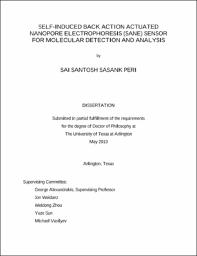
ATTENTION: The works hosted here are being migrated to a new repository that will consolidate resources, improve discoverability, and better show UTA's research impact on the global community. We will update authors as the migration progresses. Please see MavMatrix for more information.
Show simple item record
| dc.contributor.advisor | Alexandrakis, George | |
| dc.creator | Peri, Sai Santosh Sasank | |
| dc.date.accessioned | 2021-06-03T20:18:00Z | |
| dc.date.available | 2021-06-03T20:18:00Z | |
| dc.date.created | 2019-05 | |
| dc.date.issued | 2019-05-15 | |
| dc.date.submitted | May 2019 | |
| dc.identifier.uri | http://hdl.handle.net/10106/29894 | |
| dc.description.abstract | We fabricated a novel single molecule nanosensor by integrating a Solid-State Nanopore (SSNP) and a Double Nanohole (DNH) nanoaperture. The nanosensor employs Self-Induced Back-Action (SIBA) for optical trapping and enables SIBA-Actuated Nanopore Electrophoresis (SANE) for concurrent acquisition of bimodal optical and electrical signatures of molecular interactions. We demonstrated the potential utility of the SANE sensor by trapping and translocating 20 nm silica and gold nanoparticles. The electrical translocation time of the nanoparticles was extended by four orders of magnitude due to opposing electrical and optical forces acting on the nanoparticle, causing high frequency oscillations or bobbing in the electrical signal. Using frequency analysis, we were able to show that bobbing can be used as a signature to distinguish between single and multiple trapping. These promising results enabled us to pursue biomolecular detection with SANE sensor. We used high affinity T-cell receptor-like antibodies (TCRmAbs), and tested their binding to specific peptide-presenting Major Histocompatibility Complex (pMHC) ligands. We used irrelevant TCRmAbs, targeting the same pMHCs as control experiments. We were able to distinguish between individual molecules and their specific and non-specific mixtures. The optical-electrical metrics enabled measurement of increased bound fraction of the antibody-ligand complexes at lower concentrations than bulk solution equilibrium binding constant (KD). In addition, we detected low affinity ligand-receptor interactions between soluble heterodimer receptors and pMHC ligands. We used irrelevant pMHCs to target the same receptor as a control experiment. We discriminated the optical-electrical signatures for specific and nonspecific binding of receptor-ligand interactions, and were able to quantify the dissociation rate constant (koff) of the receptor-ligand binding comparable to the commercial technologies. The measurement koff value can be correlated to the receptor-ligand binding time required for activation of immune response in vivo. Therefore, we demonstrated the utility of SANE sensor as a potential screening tool in cancer immunotherapy. | |
| dc.format.mimetype | application/pdf | |
| dc.language.iso | en_US | |
| dc.subject | Solid-state nanopores | |
| dc.subject | Dual nanoholes | |
| dc.subject | Nanopore trapping | |
| dc.subject | Nanoparticles | |
| dc.subject | Nanopore sensing | |
| dc.subject | Dual modality nanoparticle sensing | |
| dc.subject | Immunotherapy | |
| dc.subject | Antigen | |
| dc.subject | Antibody | |
| dc.subject | TCR monoclonal antibodies | |
| dc.subject | Receptors | |
| dc.subject | Ligands | |
| dc.subject | Single molecule sensing | |
| dc.subject | Molecular interactions | |
| dc.subject | Binding affinity | |
| dc.subject | Equilibrium constant | |
| dc.subject | Kinetic rate constant | |
| dc.subject | KD | |
| dc.subject | Koff | |
| dc.subject | cancer immunotherapy | |
| dc.subject | Immunotherapeutic antibodies | |
| dc.subject | Antigen-antibody complexes | |
| dc.subject | Proteins | |
| dc.subject | Binding and unbinding of proteins | |
| dc.title | SELF-INDUCED BACK ACTION ACTUATED NANOPORE ELECTROPHORESIS (SANE) SENSOR FOR MOLECULAR DETECTION AND ANALYSIS | |
| dc.type | Thesis | |
| dc.degree.department | Electrical Engineering | |
| dc.degree.name | Doctor of Philosophy in Electrical Engineering | |
| dc.date.updated | 2021-06-03T20:18:01Z | |
| thesis.degree.department | Electrical Engineering | |
| thesis.degree.grantor | The University of Texas at Arlington | |
| thesis.degree.level | Doctoral | |
| thesis.degree.name | Doctor of Philosophy in Electrical Engineering | |
| dc.type.material | text | |
| dc.creator.orcid | 0000-0002-7224-9433 | |
Files in this item
- Name:
- PERI-DISSERTATION-2019.pdf
- Size:
- 3.213Mb
- Format:
- PDF
This item appears in the following Collection(s)
Show simple item record


